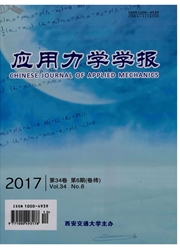

 中文摘要:
中文摘要:
为探究水泥混凝土路面长期遭受风沙环境下的冲蚀磨损损伤机理,根据中国西北地区风沙环境的特征,利用模拟风沙环境侵蚀试验系统研究水泥砂浆在风沙环境下的冲蚀磨损行为。通过冲蚀率来评价水泥砂浆受风沙冲蚀磨损程度,分析了不同冲蚀速度、不同冲蚀角度下水泥砂浆冲蚀率的变化规律;采用扫描电子显微镜(SEM)和激光共聚焦扫描显微镜(LSCM)观测水泥砂浆受冲蚀损伤的表面微观形貌,研究水泥砂浆受冲蚀损伤机理;运用相似理论分析实际工况冲蚀时间和室内模拟冲蚀时间的对应转化关系。研究结果表明:冲蚀角度恒定时,冲蚀率随着冲蚀速度的增大而增大;下沙率恒定、冲蚀角度在30°-90°时,冲蚀率的增长比较明显,近似成正比例变化,90°时冲蚀率达到最大;冲蚀角度是影响冲蚀行为的重要因素,低角度冲蚀时水泥砂浆表现为塑性变形,主要由水平方向的沙粒切削作用导致变形,高角度冲蚀时水泥砂浆表现为脆性破坏,主要由沙粒垂直方向的冲击作用导致材料表面产生冲蚀坑;试验中下沙率越大,由计算结果推算的实际工况中冲蚀磨损时间越长;研究结果可为风沙环境下水泥混凝土路面受磨损损伤研究提供依据。
 英文摘要:
英文摘要:
Based on the characteristics of sandstorm environment in the northwest of China, a simulated sandstorm experiment was conducted to investigate the erosion behavior of cement mortar and the erosive wear damage mechanism of concrete pavement under the environment of sandstorm. The erosion rate of cement mortar was used to evaluate the degree of erosive wear of cement mortar. The change law of erosion rates of cement mortar was analyzed from the different erosion velocity and angle. The surface microtopography of cement mortar was observed by scanning electron microscope (SEM) and laser scanning confocal microscopy (LSCM), whilst the damage mechanism of cement mortar was investigated. The similarity theory was used to analyze the corresponding transformation relationship between actual erosion time and erosion time simulated in laboratory. The results show that when the erosion angle is constant, the erosion rate increases with the increase of the velocity. When the erosion angle is in the range of 30° to 90°, there is an obvious increase in the erosion rate with the constant sand flow rate. The erosion rate increases in proportion, and when erosion angle is 90°, the erosion rate reaches the peak. The erosion angle is the most important factor which influences the erosion behavior. The deformation of the cement mortar with low angle erosion is in the form of plastic deformation, mainly caused by the cutting action of sand along horizontal direction. However, the deformation of the cement mortar with high angle erosion is in the form of brittle damage. The erosion pits on the surface is mainly caused by the vertical impact of sand. The greater the sand flow rate in the experiment is, the longer the erosive wear time in actual conditions can be. The results provide the basis for the research on the wear and damage of cement concrete pavement in the sandstorm environment.
 同期刊论文项目
同期刊论文项目
 同项目期刊论文
同项目期刊论文
 期刊信息
期刊信息
